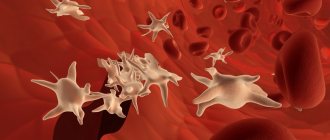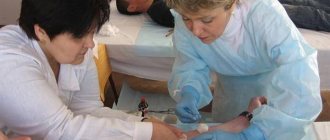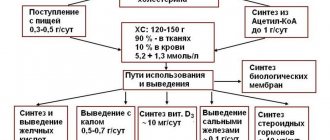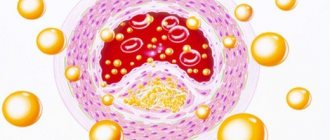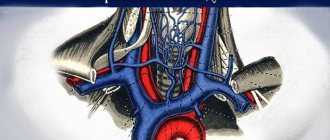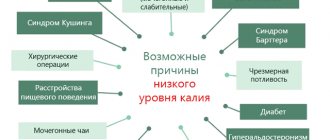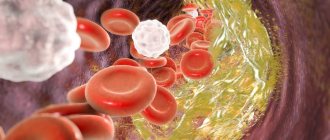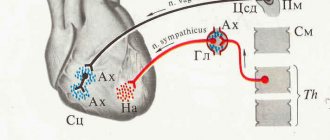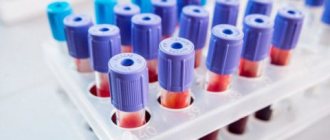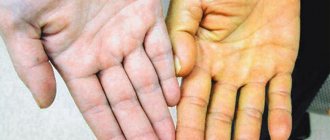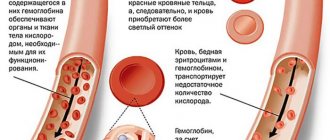You are here: Blood test -
Red blood cells
- Structure of the CCP
- Education and life cycle
- Functions of red blood cells
- Norms of red blood cells in urine
- Normal in blood
- Reasons for promotion and demotion
Red blood cells are disk-shaped red blood cells concave inward at the center. The main task of this blood component is to supply the body with oxygen and hemoglobin. Iron-containing protein makes up 95% of the dry residue of the cell.
It is noteworthy that the total surface area of the cells is 3000 square meters, which is 1500 times larger than the human body. The shape of red blood cells and this area ensure a stable supply of oxygen in the required quantity - this is the main function of red blood cells.
The optimal amount of red cells in the body is very important at any age. The indicator needs to be monitored, if there are appropriate symptoms, consult a doctor, and not ignore the problem.
The average number of red blood cells in the blood (per cubic liter of blood) is 3.5–5 billion cells. The norm of red blood cells in the blood of women will be less than that of men, which is not considered a pathology.
Structure of the CCP
Red blood cells have a structure that is strikingly different from other blood components, since they do not have a nucleus or chromosomes. This form of red blood cells makes it possible for the cells to squeeze through the thinnest capillaries and deliver oxygen to any cell. The size of a red blood cell is 7–8 microns.
The chemical composition of the bodies is as follows:
- 60% water;
- 40% dry residue.
The dry remainder of the component in the blood consists of 90–95% hemoglobin. The remaining 5–10% is occupied by lipids, carbohydrates, fats and enzymes, which ensure the function of red blood cells in the body.
The structure of red blood cells
What are red blood cells
The shape and size of a blood cell can be determined using an electron microscope. Normally, it is a biconcave disk, the diameter does not exceed 7-8 microns. Among all the formed elements of blood, red blood cells have the highest concentration. Their number exceeds the content of platelets and leukocytes. One drop of human blood contains about 100 million cells.
A mature element has its own shell, it does not have a nucleus or organelles. The cell has only a framework (cytoskeleton). The red blood cell is filled with cytoplasm, which is a concentrated liquid. This is achieved by saturating hemoglobin with pigment. In addition to hemoglobin, the red blood cell contains:
- water;
- protein;
- enzymes;
- salt;
- lipids;
- carbohydrates.
Hemoglobin is a protein that consists of heme and globin. Heme contains iron atoms. They bind with oxygen in the lungs, which gives the blood a scarlet color. After oxygen enters the tissues, the biological fluid acquires a dark tint. The biconcave shape of the red blood cell increases its total surface area. Due to this, gas exchange processes between blood and cells are improved.
This is interesting! Red blood cells have good elasticity. Their small diameter and flexibility ensure ease of passage through the smallest vessels - capillaries, whose diameter does not exceed 2-3 microns.
The lifespan of red blood cells is 120 days (they live for 4 months). During this period, they manage to perform all functions. Then they are destroyed. The place of death of red blood cells is the spleen, liver. If a cell, under the influence of unfavorable external or internal factors, acquires a pathological shape, its destruction occurs faster.
Cell formation and life cycle
Red blood cells are formed from precursor cells that originate from stem cells. If for some reason the bone marrow is not able to produce CCT, these functions are taken over by the liver and spleen.
Red blood cells originate in flat bones - the skull, ribs, pelvic bones and sternum. The lifespan of red blood cells will depend on the general indicators of the functioning of the body, so it is impossible to definitively answer the question of how long red blood cells live. On average it is 3–3.5 months.
Every second, about 2 million cells disintegrate in the human body, and new ones are produced in return. Cell destruction, as a rule, occurs in the liver and spleen - instead of them, bilirubin and iron are formed.
Red cells can disintegrate not only due to physiological aging and death. The life cycle can be significantly shortened due to the following factors:
- under the influence of various toxic substances;
- due to hereditary diseases - the most common cause is spherocytosis.
The structure of erythrocytes is disc-shaped; when they disintegrate, the contents go into the plasma. But if hemolysis (the breakdown process) is too extensive, it can lead to a decrease in the number of moving bodies, causing hemolytic anemia.
Where and how do they die?
Worn-out red blood cell cells are removed by myeloid phagocytic cells called macrophages, located primarily in the bone marrow, liver, and spleen. Part of the hemoglobin of destroyed red blood cells is additionally processed as follows:
- Globin, the protein portion of hemoglobin, is broken down into amino acids that can be sent back to the bone marrow to produce new red cells. Hemoglobin that is not phagocytosed is broken down in the bloodstream, releasing alpha and beta chains, which are cleared from the bloodstream by the kidneys.
- The iron contained in the heme portion of hemoglobin may be stored in the liver or spleen, primarily in the form of ferritin or hemosiderin, or transported through the bloodstream via transferrin to the red bone marrow for recycling into new red blood cells.
- Non-iron heme is broken down into biliverdin and then into bilirubin. Bilirubin binds to albumin and travels through the blood to the liver, which uses it to produce bile. In the colon, bacteria break down bilirubin and convert it into urobilinogen and then stercobilin. It is then excreted from the body in feces. Broad-spectrum antibiotics kill these bacteria and may change the color of the stool. The kidneys also remove any circulating bilirubin and other associated metabolic byproducts, such as urobilins, and excrete them into the urine.
Important information: What is platelet aggregation in the blood (analysis transcript)
Thus, red blood cells are formed in the red bone marrow and sent into the blood circulation. At the end of their life cycle, they are destroyed by macrophages, and their components are recycled.
Functions of red blood cells
The functions of red blood cells are as follows:
- with the participation of hemoglobin, oxygen is transported to tissues;
- with the help of hemoglobin and enzymes they transport carbon dioxide;
- take part in the regulation of water-salt balance;
- fatty acids are delivered to tissues;
- the shape of red blood cells partially ensures blood clotting;
- perform a protective function - they absorb toxic substances and transport immunoglobulins, that is, antibodies;
- suppress immunoreactivity, which reduces the risk of developing cancer;
- maintain optimal acid-base balance;
- take part in the synthesis of new cells.
Many of these functions are possible because red blood cells are disc-shaped and have no nucleus.
Red blood cell count
A red blood cell count is a blood test that is used to determine the number of red cells in the blood. The test is important because blood cells contain hemoglobin, which carries oxygen to body tissues. Their magnitude influences how much oxygen tissues receive in order to function. If the amount is too high or low, symptoms and complications may occur.
Low red blood cell count, symptoms may include:
- fatigue;
- shortness of breath;
- dizziness, weakness;
- increased heart rate;
- headache;
- pale skin.
High level of red blood cells, the following symptoms may occur:
- joint pain;
- itchy skin, especially after a shower or bath;
- sleep disturbance.
This is interesting! When blood is centrifuged to force the cells to settle, the volume of red blood cells is 42 to 54% of the total volume in men and 37 to 47% in women. The values are slightly lower in children.
Basic functions of red blood cells
Red blood cells play an important role in hemostasis and thrombosis, both of which mean blood clotting and can act as a procoagulant. This means that it helps in converting inactive prothrombin into the active enzyme thrombin, which is necessary for blood clotting.
The main functions of red blood cells are:
- In the transport of oxygen from the lungs to the body's tissues and carbon dioxide as waste, from the tissues and back to the lungs.
- Red cells are also the second largest contributor after sodium to blood osmolarity, which is important for fluid balance in the body.
- A deficiency of red blood cells can cause swelling because the blood is then unable to absorb the usual amount of water from the tissues around the capillaries.
Life cycle of red blood cells
The production of red blood cells in the bone marrow occurs at a staggering rate of over 2 million cells per second. In order for this production to occur, the amount of raw materials must be present in sufficient quantities. These include nutrients necessary for the maintenance of any cell, such as glucose, lipids and amino acids.
However, the production of red blood cells also requires several micronutrients:
- Iron. Each heme group in a hemoglobin molecule contains an ion of the trace element iron. On average, less than 20 percent of the iron consumed is absorbed. Heme iron from animal foods, such as meat, poultry and fish, is absorbed more efficiently than from plant foods. The bone marrow, liver and spleen can accumulate iron in the protein compounds ferritin and hemosiderin. Ferroportin transports iron across the plasma membranes of intestinal cells and from its storage sites into tissue fluid, where it enters the blood.
- Copper. The trace element is a component of two plasma proteins, hepestin and ceruloplasmin. Without them, hemoglobin cannot be adequately produced. Located in the intestinal villi, hephaestin allows iron to be absorbed by intestinal cells. In a state of copper deficiency, the transport of iron for heme synthesis is reduced, ultimately leading to organ damage.
- Zinc. It functions as a coenzyme that facilitates the synthesis of the heme portion of hemoglobin.
- B vitamins. They facilitate DNA synthesis. They are important for the synthesis of new cells, including red blood cells.
On a note! Red blood cells live up to 120 days in the circulation, then worn-out cells are removed by a type of myeloid phagocytic cell called macrophages. They are located mainly inside the bone marrow, liver and spleen.
Functions of hemoglobin and its compounds
Hemoglobin is a respiratory pigment that binds to oxygen or carbon dioxide. This allows oxygen to be delivered throughout the body to tissues and organs and carbon dioxide to be removed. Hemoglobin is mainly composed of iron, which, when combined with oxygen, gives blood its red color. In the arterial circulation, hemoglobin has a high affinity for oxygen and a low affinity for carbon dioxide, organic phosphates, as well as hydrogen and chlorine ions.
When red blood cells die, hemoglobin is broken down: the iron is transferred to the bone marrow by proteins called transferrins and used again in the production of new blood cells. Most hemoglobin forms the basis of bilirubin, a chemical that is excreted in bile and gives feces its characteristic yellow-brown color.
Hemoglobin compounds
One hemoglobin molecule contains 4 heme groups, each of which contains one iron atom. Heme, which makes up only 4 percent of the molecule's mass, is composed of a ring-shaped organic compound known as a porphyrin with an iron atom attached to it. It binds oxygen as blood moves between the lungs and tissues. Each hemoglobin molecule contains four iron atoms, which, accordingly, can connect four oxygen atoms. The next part of the hemoglobin molecule is organic, containing several protein chains.
Norms of red blood cells in urine
The presence of red cells in urine is medically called hematuria. This happens because, due to certain etiological factors, the capillaries of the kidneys become weaker and allow blood components to pass into the urine.
In women's urine, the norm of red blood cells is no more than 3 units. The norm for men is no more than two units. If a urine test is performed according to Nechiporenko, up to 1000 units/ml is considered normal. Exceeding this parameter will indicate the presence of a pathological process.
The norm of red blood cells in the urine of a child
Significance of human studies
Until some time, the knowledge that the lifespan of red blood cells in human blood is 120 days did not help practical medicine in any way. However, after the discovery of the ability of hemoglobin to bind to certain substances, new possibilities opened up. In particular, the method for determining glycated hemoglobin is widely used today. This gives information about how high your glycemic levels have been in the last three months. This significantly helps in diagnosing diabetes, as it allows you to find out how blood glucose increases.
Normal in blood
It should be understood that the total number of red blood cells in women or men by age and the norm in the circulatory system are not the same thing.
The total number includes three types of red blood cells:
- those still developing in the bone marrow;
- those that will soon leave the bone marrow;
- those that already travel through the blood system.
Red blood cells in the blood of women are contained in smaller quantities, which is due to the loss of a certain amount of blood during the menstrual cycle. The normal content of red blood cells in the blood of women is 3.9–4.9 × 10^12/l.
The normal rate of red blood cells in men is 4.5–5×10^12/l. Higher rates are due to the production of male sex hormones, which produce their synthesis.
In children, red cells should normally be contained in the following quantities:
- in newborns - 4.3-7.6 × 10^12/l;
- in a two-month-old baby - 2.7–4.9 × 10^12/l;
- by year - 3.6–4.9×10^12/l;
- in the period from 6 to 12 years - 4–.5.2 × 10^12/l.
During adolescence, red blood cell counts are compared with adult norms. More specific figures by age will be provided by a table that can be found on the Internet.
Place of formation of red blood cells
It is important to know where red blood cells are formed so that if problems arise with their concentration in the blood, you can take timely measures. The process of creating them is complex.
The place of formation of red blood cells is the bone marrow, spine and ribs. Let's take a closer look at the first of them: first, brain tissue grows due to cell division. Later, from the cells that are responsible for creating the entire human circulatory system, one large red body is formed, which has a nucleus and hemoglobin. From it the precursor of the red blood cell (reticulocyte) is directly obtained, which, upon entering the blood, is transformed into an erythrocyte in 2-3 hours.
